A mid-season onion variety with good frost tolerance "Chalcedony"
Chalcedony is an onion variety that ripens quickly and yields a good harvest. In one season, a total of up to 5.5 kg can be harvested from one garden bed. It is usually sown in April, and the bulbs are harvested at the end of July - August. Most vegetable growers prefer this variety because of its good keeping quality and adaptability to any climatic conditions.
In this article you will find the characteristics of the Chalcedony onion variety, a description of the methods of growing from seeds through seedlings and direct sowing into the ground, as well as reviews about it and advice from experienced gardeners.
The content of the article
Description of the variety
it mid-early onions for table and forcing with a spicy taste of heads, mainly for commercial purposes. The authorship belongs to Moldovan breeders.
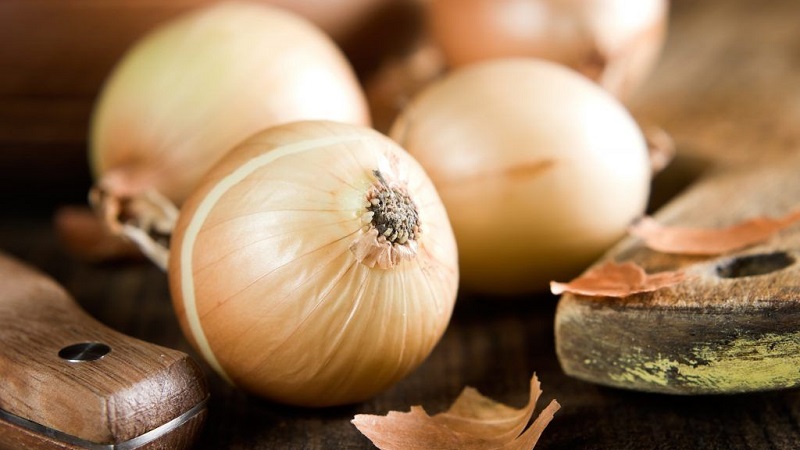
Origin and development
The birthplace of Chalcedony is the Republic of Moldova. It was brought out by the specialists of the Pridnestrovian Research Institute of Agriculture, and included in the state register in 1993. Growing areas: middle lane, central and southern parts of Russia, Moldova, Ukraine.
Chemical composition, trace elements, vitamins and beneficial properties
Onion contains folic acid (up to 8%), essential oils (10-11%), carotene... Vitamin PP in this onion variety is 0.2 mg, and vitamin C - 10 mg. There is also a lot of vitamins B1, B2, B6 in onion heads. And in the onion husk there are about 17 trace elements useful for the human body.
Ripening period
The variety is mid-season. Ripening period is approximately 110 days - in 3.5 months after the appearance of the first shoots, you can harvest.
Yield
This onion variety is famous for its high yield - from 1 sq. sq. m collect from 3 to 8 kg... Bulb mass - from 90 to 130 g.
Reference. The bulbs grow well in one summer season, both when sowing seeds in the garden, and when growing in seedlings.
Disease resistance
Variety prone to cervical rot and peronosporosis, as well as attacks by insects such as onion fly, stem nematodes and thrips.

Characteristics of the bulb, description of the appearance, taste
An annual plant with a large turnip. The color of the bulb is copper, in the context of white. Sometimes her dimensions reach 15 cm in diameter, and weight - 130 g... Green feather from 16 to 45 cm high, juicy and not too bitter. The vegetable prefers fertile soil and abundant watering. Not afraid of frost, light-loving and unpretentious in care.
Growing regions and climate requirements
Sow this vegetable possible in any regions of Russia with a temperate climate... But the southern regions, where there is a lot of light and heat, are best suited for him, in particular, the North Caucasian and Lower Volga regions of Russia. Chalcedony ripens perfectly in Ukraine and Moldova.
Important! In the south, Chalcedony can be planted directly on the garden bed. In colder areas, as well as in central Russia, it is planted by seedling. In the latter case, the vegetable does not go to the arrow and has time to ripen even in cold climates.
Advantages and disadvantages, differences from other varieties
 The advantages of Chalcedony onions are obvious:
The advantages of Chalcedony onions are obvious:
- Almost the entire harvested crop (93%) is stored for a long time.
- Dense plantings do not affect the high yield of the crop - 90% of good, mature bulbs.
- Plant seeds can germinate even at + 3 ° C. For many onion varieties, this temperature is fatal. Plants tolerate dry summers well, although they need systematic watering.
- It is immune to many diseases.
Lack of need for regular maintenance and watering after the appearance of the first shoots within the first one and a half months.
Features of planting and growing
Chalcedony needs fertile soil and an abundance of light... The culture loves moisture, but does not tolerate stagnation of water at the roots.
Preparing for landing
Chalcedony grown both by planting seedlings directly into the ground and seedlings.
With the seed method seeds are poured onto paper and sorted out. Too small and damaged are thrown away. Further seed placed on a saucer, covered with gauze and add a weak solution of potassium permanganate. After 1-2 days, the seeds are washed in clean water and dried.
For growing seedlings you need to stock up on fertilized soil. The prepared seed is placed in soil and lightly sprinkled with earth. Until April, seedlings are placed in a warm, well-lit place indoors.
Attention! In cloudy weather, the bow needs additional lighting with fluorescent lamps. It is advisable to ensure that there are no drafts in the room.
Soil requirements
For Chalcedony the land on the site should be prepared in advance, in the fall... Before you dig up the soil, you can add fertilizers - humus and compost (4-6 kg per 1 sq. M). You can also use wood ash - 300 g per 1 sq. m.
This variety of onion does not tolerate acidic soils... Soil acidity should be close to neutral (6.4-7.9).
It is important to pay attention to predecessors Chalcedony. It is better to sow it after crops for which a large amount of organic fertilizers was applied. It can be cucumbers, zucchini, pumpkin.
Reference. For good germination of a vegetable and its successful ripening, it is not recommended to plant a crop in the same place for four years.
Timing, scheme and landing rules
The plant is photophilous, so the planting site is chosen in an open sunny area. Preliminary compost, humus or ash solution is added to the ground... Then it is carefully dug up, loosened and pits about 2-4 cm deep. Heads are placed there at a distance of 7-10 cm.
Sowing scheme - 5 × 25 cm, seeds are lowered to a depth of 10-15 mm.
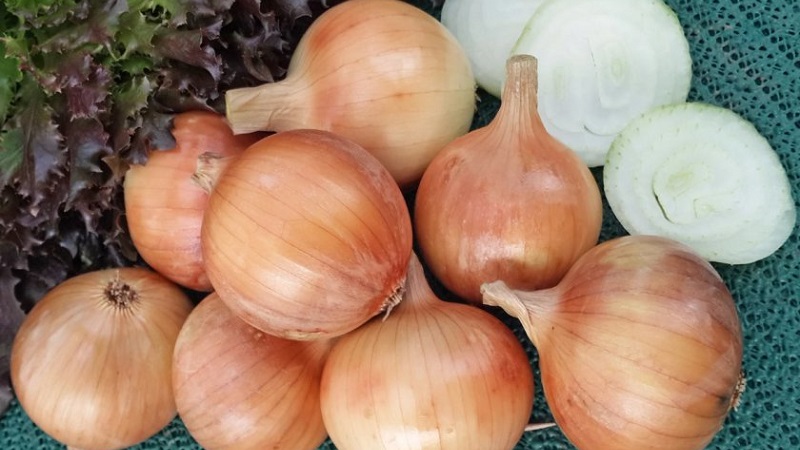
The nuances of care
Plant gives green feathers at an air temperature not lower than + 14 ... + 26 ° С and abundant regular watering. However, it can be planted in open ground even at + 15 ° C.
Young plants are able to safely tolerate frosts down to -8 ° C and heat up to + 35 ° C. But when grown in open areas, they require careful care at first.
Too dense plantings need to be thinned out and at the same time pull out the extra onion from the ground along with the roots. It is also advisable to loosen the ground every time you weed. In the area with Chalcedony, the accumulation of melt or rainwater is undesirable.
Watering mode
Outdoors on hot days watered once a week, in cloudy weather you don't need to water at all.
Immediately after planting Chalcedony in open ground, for almost the entire June, it is necessary to moisten the ground once every 7 days (9-11 liters per 1 sq. M), and in the first half of July, slightly reduce the amount of liquid to 7-9 liters per 1 sq. M. m.
Attention! Watering should be done at the root so as not to damage the feathers. It is best to use water that has stood in the sun for this purpose.
Loosening the soil and weeding
Weed the vegetable already when the first shoots appear... To protect ripening bulbs from mechanical damage, this is done by hand. Loosening and weeding are carried out in parallel with watering the plant.
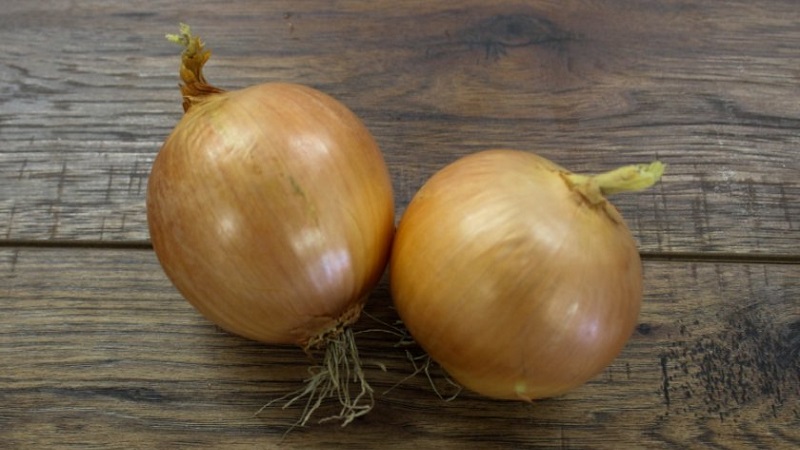
Top dressing
Fertilizing culture start when feathers reach 10 cm... Fertilize onions twice with a break of 14 days. The growing vegetable is suitable for mineral fertilizers, as well as nitrogen and potassium supplements.
During ripening, the bulbs can be root-fed with Agricola for Onions and Garlic or Effekton-O. The break between dressings is 12 days.
Reference. It is not recommended to add fresh manure to the soil before planting onions in a permanent place. Such additives will lead to abundant green mass growth and deplete the bulb heads. Turnips can ripen small, diseases will arise.
Disease and pest control
The variety is prone to neck rot and downy mildew (downy mildew).To avoid decay, plantings are thinned out during weeding and do not allow the vegetable to be flooded with water... In order to disease prevention the ground on the site is sprinkled with chalk, and the rotten onions are dug up and burned.
To prevent downy mildew (spots on leaves) Onions are planted in well-lit areas. To combat it, spraying with a 1% solution of Bordeaux liquid is used. Also help "Polykarbatsin" (40 g per 10 liters of water) "Arcerid" (30 g per 10 liters of water).
What kind insect pests can ruin crops Chalcedony:
- Stem nematode... When infected, the bulb begins to deteriorate and gradually turns into dust. The pest can destroy up to 70% of the plantings and spoil the harvested crop. It penetrates the storage and crawls from infected heads to healthy ones.
- Onion fly... When infected by insect larvae, the stems dry up, and the heads become soft and exude an unpleasant odor.
- Tobacco thrips... The insect settles in the leaf sinuses. Later, whitish spots appear on the onion stalk. Gradually the stems turn yellow and dry out. The bulbs become small and do not develop. The pests, along with the harvested onion crop, enter the vegetable store, where they continue to eat the bulbs.
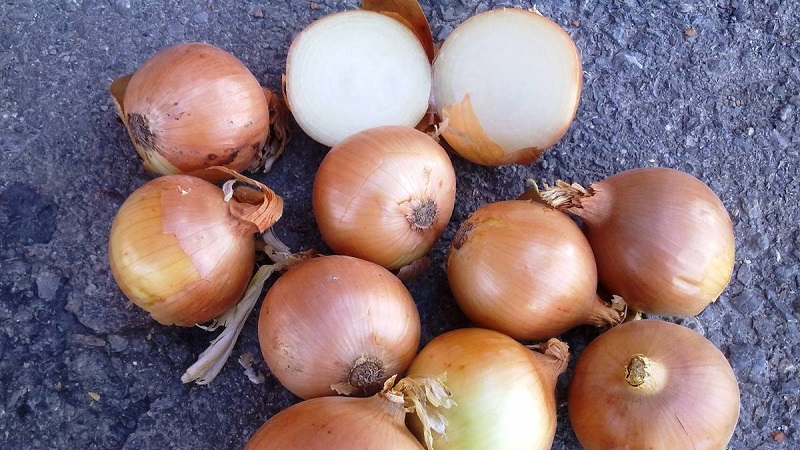
To combat insects, it is necessary to disinfect seeds and seedlings before planting, carefully dig up the area, observe crop rotation.
The onion fly can be destroyed by both chemicals such as "Aktara", "Sochva", "Alatar", and folk remedies. For example, plantings are dusted with ash: every two weeks they are poured into the aisles on wet soil and the ash is lightly sprinkled with earth on top.
To avoid contamination with tobacco thrips, it is important to weed out weeds in a timely manner, dig deep into the area, observe the alternation of vegetable crops in the garden and not sow onions on the infected and the same areas for four years.
To combat stem nematode the ground is treated with brine: 2 tbsp. l. salt per 10 liters of water. This infusion is watered several times per season.
Against tobacco thrips use "Karate Zeon" and "Fastak".
In the spring, oil radish and white mustard are sown on the future onion plot to prevent contamination of the culture. Then, when these plants bloom, carefully dig up the soil. You can also cope with pests if urea is added to the ground before planting onions (500 kg per 1 ha of area).
Growing difficulties
We need to take care of the land for Chalcedony in time. It is important that there is enough sulfur in it. For this purpose the soil is fertilized with potassium sulfate and ammonium sulfate... It is also necessary to pour the liquid into the grooves when watering the plant, and not by sprinkling. Otherwise, the plants run the risk of contracting downy mildew.
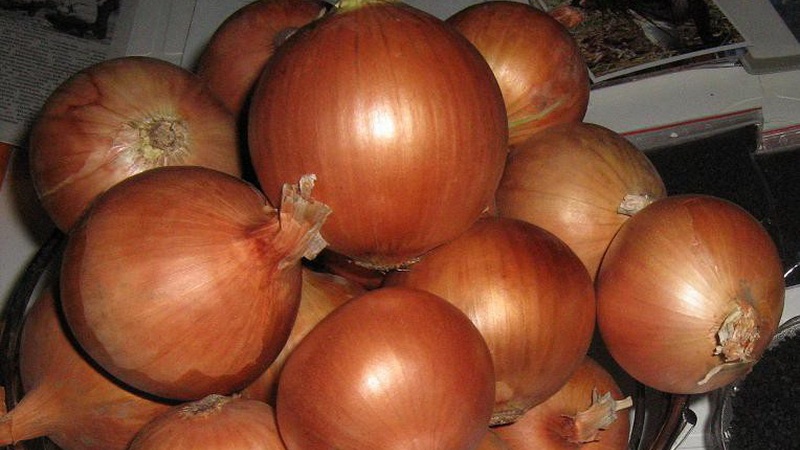
Harvesting and storage
Optimal collection time ripe onions - from late July to mid-September, three months after planting.
How and when to collect
Readiness to collect will show such signs:
- the head of the bulb has acquired a brown-copper color;
- the neck of the feather began to dry out and become thinner;
- almost the entire feather was dry and yellowed;
- stems spread along the ground.
In summer, in dry weather, preferably immediately after harvesting, put the bulbs to dry in the sun in a week.Then they should be removed under the canopy to ripen for a few more days and only then taken to the basement or shed for storage.
Important! After harvesting from the garden, the green feather is cut off from the bulbs, leaving a stump of 3 cm.
Storage features and keeping quality of the variety
The preservation of the bulbs depends on many reasons, but generally this vegetable tolerates winter well.... To keep the bulbous heads as long as possible, the following rules must be observed:
- You need to store them in a dried or completely dried form. Do not put the bulbs in dense plastic bags - a greenhouse effect will appear, bacteria will start. An old proven method is to braid the bulbous stems and hang them.
- Before storage, you should carefully examine the vegetables and discard the damaged ones.
- In city apartments, a loggia, a pantry, a balcony serve as a storage place for vegetables. The main thing is that dry air circulates in the room where the onions are stored, the humidity does not exceed 50-75%, the temperature does not rise above + 25 ° C and does not drop below -5 ° C.
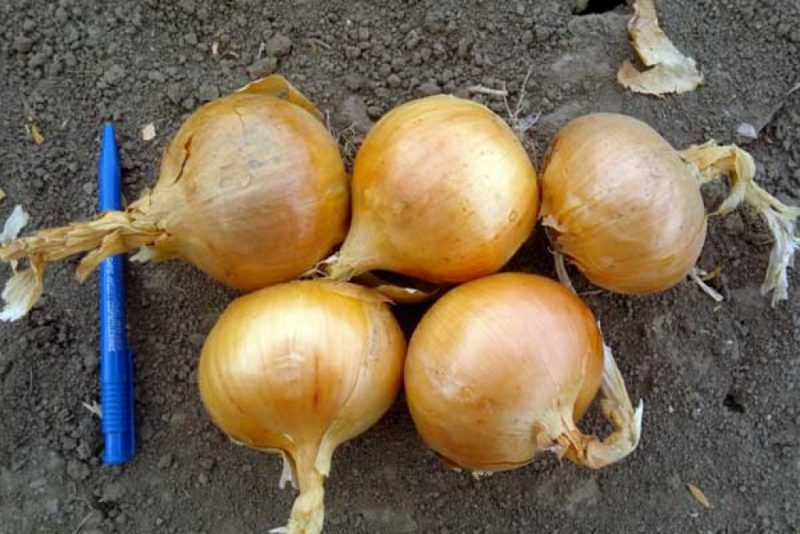
Advice and feedback from experienced gardeners
Useful tips will be useful even for experienced vegetable growers.
Nikolay, Kryvyi Rih: “Even in the first year of cultivation, I noticed that Chalcedony likes moist soil, but not too wet. After the summer rains, when the bulbs were already gaining weight, I tried to loosen the ground on the onion ridge immediately after the rain. Thus, the moisture was preserved longer, and the harvest pleased with large and high-quality bulbs ".
Love, Chernigov: “It so happened that my Chalcedony was attacked by tobacco thrips. The next year, I decided to bake the set at + 40 ° C in a hot oven. For two days I warmed up the heads for 5 minutes, and when it came time to plant the onions in the ground, I planted them. Since then my Chalcedony does not know this pest ".
Variety reviews, which has conquered the country's gardeners for more than 25 years, confirm its advantages.
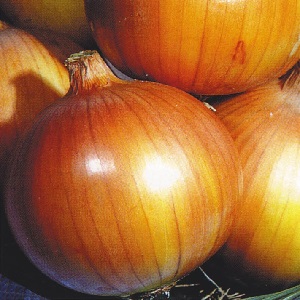 Tamara, Stavropol: “I like onions for their ease of maintenance and quick ripening. If you follow the simple rules of growing and harvesting, this vegetable variety is preserved almost completely until spring. Starting in summer, we also harvest a green feather for the winter. I freeze it in the freezer, and in winter I add it to soups, salads ".
Tamara, Stavropol: “I like onions for their ease of maintenance and quick ripening. If you follow the simple rules of growing and harvesting, this vegetable variety is preserved almost completely until spring. Starting in summer, we also harvest a green feather for the winter. I freeze it in the freezer, and in winter I add it to soups, salads ".
Ivan, Kirov: “Chalcedony is stored well, does not rot. I collect very large heads even in a lean year. I also like its taste - sharp, but pleasant. Our family loves salads with it, especially in winter, when the body needs vitamin C. Chalcedony was planted first through seedlings, now I decided to try growing from seeds (nigella) ".
Conclusion
Chalcedony onions are chosen from many varieties for frost resistance - seeds germinate at + 3 ° C, which is detrimental to others.
Even with a prolonged cold snap, Chalcedony retains its taste. In addition, it has a long shelf life and easy maintenance.